
FMP Projects
THE MOSAIC COMPANY operates the world’s largest solution mine in Belle Plaine, Saskatchewan, producing potash which is used mainly in fertilizer. New rail service to the plant required several existing buried water mains to be exposed and encased in steel to protect them from the new loads presented overhead - with all installation performed without loss of service. Stainless steel spacers were used to center, restrain, and isolate the carrier and casing pipes.
Ironhed’s Flanged Maintenance Pipe (FMP) was then installed in both two-piece (up to 42” diameter) casings and four-piece (over 42”). For the four-piece models, Ironhed shipped the sections in quarters which were site-assembled and installed as halves with staggered-seam assembly top & bottom, and closed by bolting the continuous flanges every 12 inches. The result is a strong and unitized casing throughout the length of the run. These casing also received vents and gaskets (which act as a barrier to intrusion). Installers report project completed on time.
Partners: Wappel Construction Ltd. / Kelly Panteluk Construction Ltd. / EMCO Waterworks Ltd.
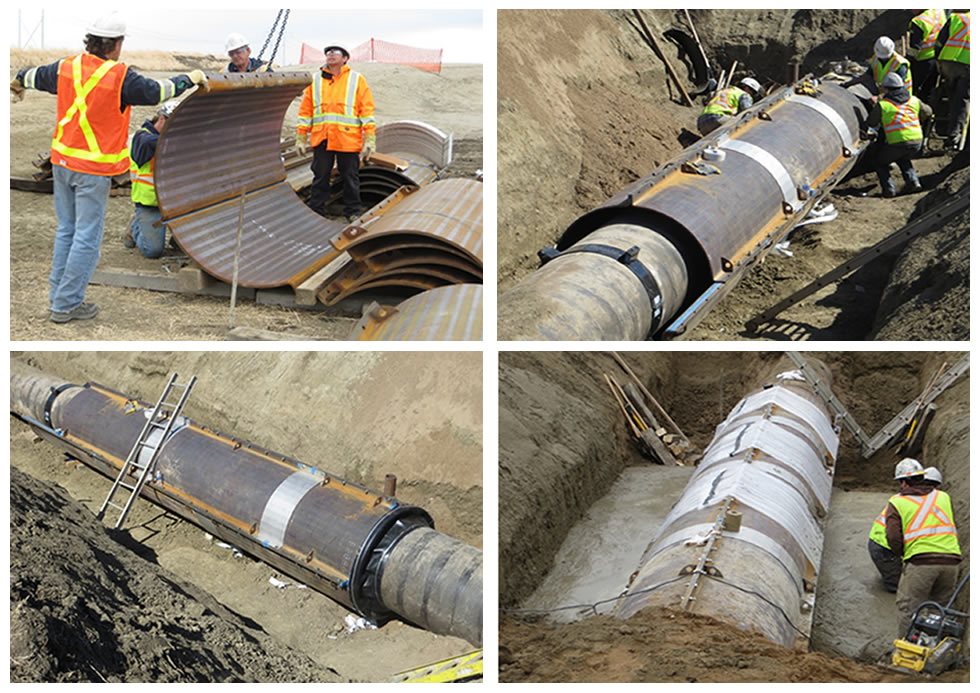
Secondary Containment - Norfolk Southern / Inman Rail Yard December 16-18, 2013
Norfolk Southern Corporation provides rail and intermodal service extensively in the eastern United States, supported by various service and maintenance facilities such the Inman Yard in Atlanta, GA. Fueling operations at Inman is representative. Pressurized diesel fuel is piped above-ground through a 6” steel main from on-site storage to the fueling point. Secondary containment for much of this pipe system is achieved by a lined trench located 3 – 4 feet below the pipe, with concrete barriers installed between pipe and a parking area. A failure of the main pipe and any resulting spill of diesel fuel is contained within the trench, draining to a sump for treatment and/or removal. This process is viable for the length of fuel pipe installed parallel to and east of a parking area of approximately 75 – 100 yds. It does not however, address containment of the pipe section that transitions to an overhead structure clearing roadway and rail lines eventually leading to the locomotive fueling facility itself.
A plan was evaluated to replace the overhead sections of the 6” main with a double-walled pipe, but abandoned due to issues of cost and service disruption. NS Corp then became aware of an alternative casing product through their engineering consultant (AECom) and on-site contractor (Herrin Industrial). The product selected was Flanged Maintenance Pipe (FMP) produced by Ironhed LLC in Columbus, OH. FMP is a two-piece steel casing with continuous side flanges providing both mechanical protection and, in this case, secondary containment in the event of a spill or rupture of the carrier fuel pipe - due to FMP’s gasket feature. 10” I.D. FMP casing was selected to protect and encapsulate the 6.625” O.D. fuel pipe. Additionally, polyethylene spacers were installed every 6’ to suspend and center the fuel pipe within the FMP casing, with Wrap-It links installed to seal the annular spaces at each end. Seven different bends required custom sweeps within this run of approximately 90’of fuel pipe. Herrin Industrial installed transducers on the casing to provide leak detection and relief access was cut into the casing with a 2” galvanized pipe installed and routed to the nearby sump.
The casing, sweeps, and couplers were fabricated by Ironhed in two weeks time, painted (ANSI – fuel specific - yellow) by the contractor and delivered to NS Corp’s Inman Yard, Atlanta. The total time required by one crew to install the casing and re-weld it to the overhead structure’s expansion brackets was three days. The project was successfully completed in December 2013 without disruption of fueling operations and within the budget anticipated.
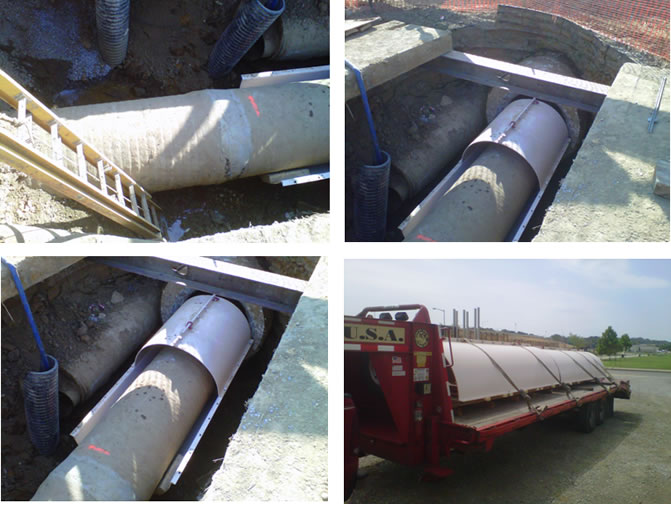
11th St. Corridor—Road Widening—Washington D.C.
This customer needed casing for protection of a 30" water main. They ordered 54" I.D. x 1/2" wall FLANGED MAINTENANCE PIPE which was sandblasted, then coated with Tnemec Hi-Build Epoxoline II in the factory. Lifting slots with shackles were provided to make handling, final placement and installation in the field as simple as possible. Once installed the new carrier/casing was to be further protected by a precast arch positioned over a cluster of existing utilities.

Stafford County - Fredericksburg, Virginia
This contractor recently sourced Flanged Maintenance Pipe for split casing which was required by Stafford County to provide mechanical protection for an existing PVC sewer pipe. This pipe was installed under planned road construction to connect a nursing home with a medical arts building in Fredericksburg. The company's owner said that he usually would buy steel pipe and couplers, saw them into halves and weld fastening tabs onto each. He then became aware of Ironhed's FMP product and was sold on its potential to save his crew time and his company money. First, the FMP product was dropped at the job site - ready for install (saving him the time and expense to unload bulk pipe at his shop, cut and fabricate the pipe and couplers, and then re-load and transport it to the job site). Secondly, Ironhed welded lifting eyes onto the corners of the FMP making its hoisting, placement, and adjustment as efficient and safe as possible. Lastly, FMP bolted together quickly with a wrench and cordless drill requiring no couplers for the straight run. The workers were concerned that the holes would line up correctly (no doubt a problem with cut & welded steel) and seemed impressed when FMP’s did every time - due to the fact that FMP is an engineered system, manufactured to close tolerances - specifically for this purpose.
NEBRASKA DEPT. OF ROADS, OMAHA
This contractor does a lot of utility relocation work. They were called out on a job in Nebraska last March to move some underground communications cabling. A Nebraska Department of Roads project required that they move and lower 1700 ft of telecommunications cable.. The plan was to expose, move the innerducts, and drop them from four feet to eight feet deep. In one section where they were building a new bridge viaduct, there was going to be forty feet of surcharge put on top of the cable. To insure protection and future access through this section, the plans called for 260 feet of 8 inch split steel casing terminated into hand holes at either end.
Every now and then a contractor gets hold of a job where everything works well and this turned out to be one of them. Even though the communications provider was requiring the contractor to use a pipe product they had never used before, that was the very thing that cut about a day of labor off the project. According to the company’s project manager, “the fiber was laying at 4 feet, so we potholed it and we dug right alongside of it down to 8 foot and then dropped into our ditch down 4 feet”, all without any harm to the cable.
For cable relocation projects, this contractor typically used steel pipe that was cut in half either with a band saw or a plasma cutter and joined with hinges, slotted tabs and fasteners. He commented, “the hinged 4 inch is the only thing we’ve ever done and if you had to do hinged 8 inch, it would have been a manhandler.” The communications provider was specifying a new type of split steel they wanted to have field trialed on this project. The split steel being called for wasn’t split at all. It was formed into what looked like a half of a piece of galvanized steel pipe with 1 inch flanges on either side. The flanges were perforated with slotted holes every 3 inches. He commented that it reminded him of the riser guard you see being used on utility poles but with a much heavier wall thickness.
Unlike the hinged split steel, the workers would only have to handle half the amount of weight during the installation process. Due to the fact it was a straight stretch they would be able to start with a 10 foot piece on the bottom and a 5 foot piece on top and stagger the joints the entire length. This would eliminate the need for any couplings and the assembled casing would be extremely strong. Another nice feature was that the inside diameter of the assembled pipe precisely matches the outside diameter of IPS sized conduit. With the extra space, they were able to fit all ten 1¼ innerducts into the casing.
According to the project manager, when they initially bid the job they figured about a day and a half of labor to put in 8” hinged steel. “We were done a heck of a lot quicker than I thought we would be.” The crew used cordless drills and installed the included stainless steel fasteners. “We zipped it together really fast. Two hundred and sixty feet took us three hours.” So with the new flanged duct they were able to place the pipe in about one fourth of the time. With regard to the rest of the job, everything went really well.

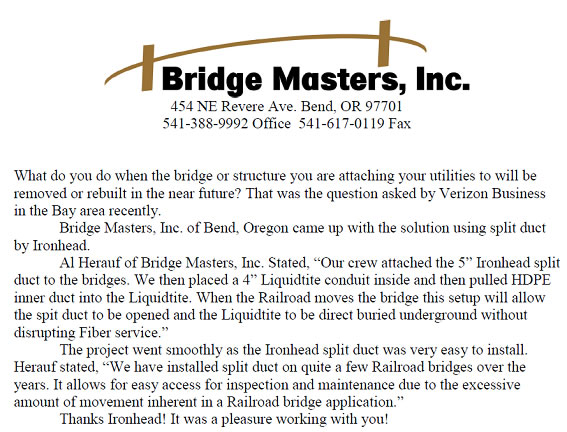
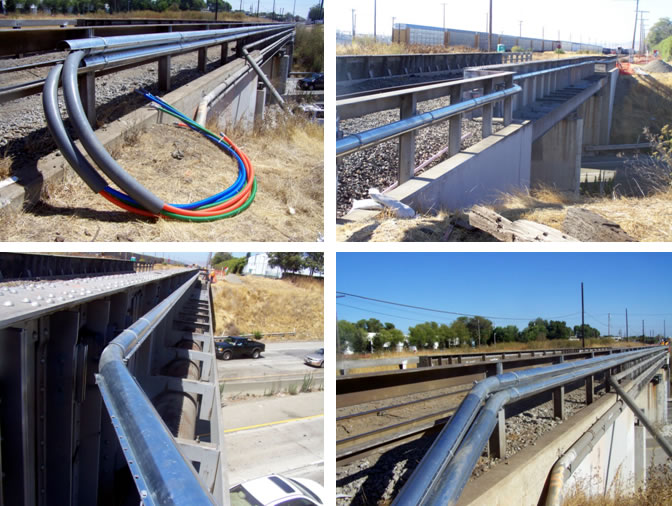
John Wedemeyer, Construction Manager
149 South 400 E. , Greenfield, IN 46140
Using FMP – Flanged Maintenance Pipe
Midwest Underground Construction, Greenfield, IN
Email: midwest2402@spcglobal.net
My name is John Wedemeyer and the company I work for, Midwest Underground, does maintenance and repair work for AT&T and MCI. When roads are widened and buried cable has to be uncovered and moved, and we are sometimes required to place a split steel encasement around the cabling for added protection before covering it up again.
The last thing you need down there is a product that is hard to install! The split steel casing we were using consisted of a five or ten foot length of pipe that had been split into two halves. Hinges were welded on to join the halves together. Due to warping (probably caused by the heat to weld on the hinges and tabs) a lot of the times the hinges wouldn’t go back together and you had to beat the bolts in and then you had to put the couplings on it. Another problem with lengthwise cut steel beyond being warped out of shape is sharp, jagged edges that the guys can get cut up on while wrestling with it down in the trench.
We then began to work with Ironhed LLC, about the difficulties of working with split steel casing. Working conditions aren’t always favorable down in the ditch; most of the time you have mud and water and everything else to contend with. Through a series of meetings, conversations and Ironhed people spending time with us out in the field to get an understanding of the environment, we worked together to come up with a better design. Ironhed was able to take our frustration with what we had and our ideas for what might work better, along with their own skills and connections and solved the problem. The Flanged Maintenance Pipe, FMP in my estimation is a far superior product to anything else available. We have used it on many projects over the past three and one half years and it performs perfectly for what we need it for.
Sincerely, John Wedemeyer
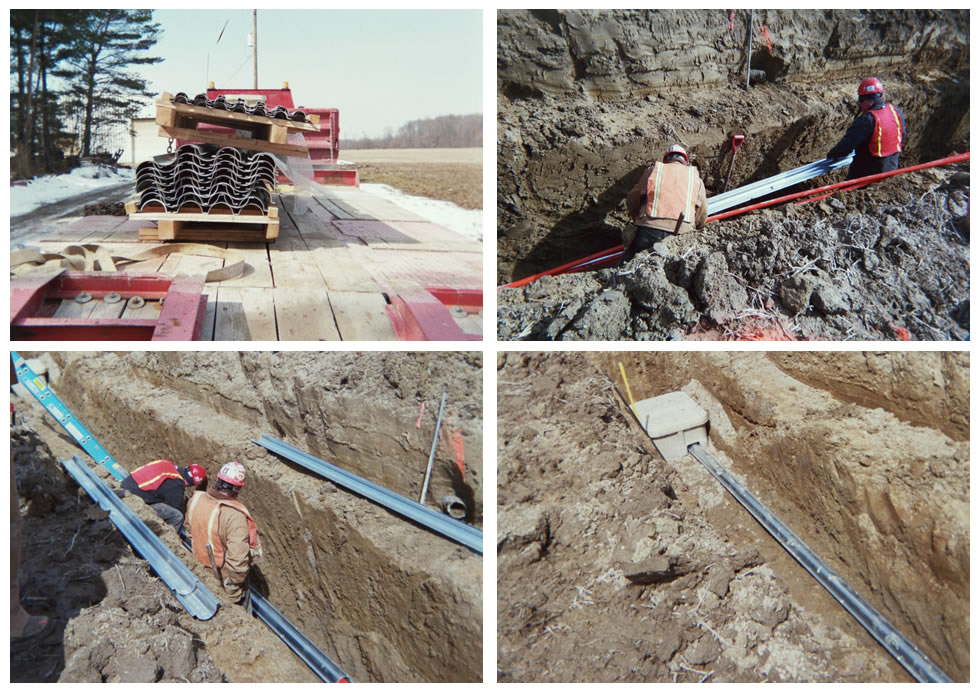
Hours of operation: Monday through Friday 8:30 A.M. to 5:00 P.M. EST





